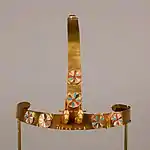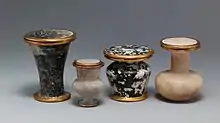Menhet, Menwi and Merti
Menhet, Menwi and Merti,[2] also spelled Manhata, Manuwai and Maruta,[3] were three minor foreign-born wives of the Eighteenth Dynasty pharaoh Thutmose III who were buried in a lavishly furnished rock-cut tomb in Wady Gabbanat el-Qurud near Luxor, Egypt. The names all fit into Canaanite name forms, although their ultimate origin is unknown.[4] A West Semitic origin is likely, but both West Semitic and Hurrian derivations have been suggested for Manuwai.[3] Each of the wives bear the title of King's Wife, and were likely only minor members of the royal harem.[5] It is not known if the women were related as the faces on the lids of their canopic jars are all different.[4]
| Menhet, Menwi and Merti in hieroglyphs | |||||||
|---|---|---|---|---|---|---|---|
Menhet | |||||||
Menwi | |||||||
Merti | |||||||
Wives of Thutmose III | |||||||
 | |||||||
The tomb of Thutmose III's foreign wives
Location and layout
The tomb, formally numbered Wady D Tomb 1, is located at the head of Wady D in Wady Gabbanat el-Qurud, southwest of the Valley of the Kings.[6] This "remote and unfrequented" area of the Theban necropolis was used as a burial ground for queens and royal children during the early Eighteenth Dynasty.[7][8] The tomb is cut into the base of the vertical cliff 30 metres (98 ft) back in a narrow cleft 10 metres (33 ft) above the valley floor. The location is such that the "mouth of the cleft is totally inaccessible to anyone standing below and equally so to anyone above, unless he has come provided with a rope to lower himself over the precipitous rock."[9] Parallels have been drawn with the tomb cut for Hatshepsut as Great Royal Wife in Wady A, that thought to belong to Neferure, and that of Thutmose III, KV34, as these tombs are in cut high into the cliff face in narrow steep-sided valleys.[9][10]
The layout is simple and consists of a short vertical shaft 1.5 metres (4.9 ft) wide and 4 metres (13 ft) deep that leads to a descending passageway 12 metres (39 ft) long. Mohammed Hammad, one of the tomb robbers, recalled that there was originally intact blocking at both ends of the passage. The corridor opens to the right onto a single chamber measuring 7.5 by 5 metres (25 ft × 16 ft)[9] with a height of 1.5–2 metres (4.9–6.6 ft).[10] There is no well shaft. Herbert Winlock noted that by the time of his visit in the 1920s the ceiling of both the chamber and passage had fallen. The tomb is entirely undecorated.[9]
Discovery and excavations

The tomb was discovered by local Qurnawi villagers on approximately 7 August 1916. Ernest Mackay, who was conducting surveying of private tombs in the Theban area, heard rumors that an impressive find of jewelry had been made in Wady Gabbanat el-Qurud and immediately alerted the Inspector of Antiquities, Tewfik Boutros; Mackay visited the tomb and also wrote several letters to inform Egyptologist Alan Gardiner in England.[11][12] Boutros did his best to identify the thieves and to obtain permission from the authorities to excavate.[11] He had the accused men taken to Luxor and their houses were searched; however, no evidence was found and the charges had to be dropped.[13] Permission was granted by 2 September and the excavation, headed by Mohammed Chaban, was conducted 14-28 September. Small finds consisting of metal, stone, and jewelry were entered into the register of the Egyptian Museum, Cairo.[11]
Later, Howard Carter investigated the valley head and cleft for signs of further tomb cuttings during his work in the wider area in 1916-17. Although he deemed the boulder-filled hollow above the tomb entrance a "very likely spot" several hours of work proved there was nothing to be found there.[14]
In October 1988 the Metropolitan Museum of Art led an excavation of the tomb and its surroundings with the aim of formally mapping the tomb and determining the accuracy of earlier accounts. Excavation focused on the tomb, its platform, and the valley head below. The tomb's roughly cut descending corridor had partially re-filled with debris over the intervening years, leaving 1 metre (3.3 ft) of crawl space. Several bats had taken up residence on the badly damaged vaulted ceiling of the burial chamber. Pharaonic remains were limited to pottery, pieces of stone vessels, beads, and glass fragments.[15] Large quantities of pottery, making up approximately 120 vessels, were found dumped below the tomb, at the head of the wady;[16] the pottery was probably originally located in the burial chamber.[17] Evidence of modern activity was seen both on the platform and within the tomb itself, with rubbish and a graffito dated 1957 seen on the sheer cliff walls of the platform, and baskets made of rubber and straw, along with two hoes found in the corridor. Smoke spots on ceiling of the burial chamber were evidence of robber's fires.[15] A small roughly cut pit tomb was discovered at the head of the wady. It contained fragmentary pieces of stone vessels and beads matching those already associated with the wives' tomb; it is suggested this represents a separate burial or simply a place that robbers had sorted through their finds.[18]
Contents
.jpg.webp)
Little is known of the original state of the tomb but it is thought to have contained three intact burials. Hammad recalled that the objects were arranged in an orderly fashion on top of a layer of limestone chips, only buried by fallen pieces of ceiling.[19] The coffins, said by Howard Carter to be sets of three nested coffins,[20] were lying side by side, with their heads against the southern wall, "totally rotted by damp."[19] Only the gold and stone objects had survived as the wood and mummies had disintegrated due to moisture "from water seeping through the cliffs above."[10] The treasures found within their tomb included gold objects such as diadems, collars, finger and toe stalls, foil sandals, and gold bracelets inlaid with carnelian and glass and inscribed with the names of Thutmose III, together with vessels of silver and stone. There was likely a gold bowl with frogs decorating the rim,[12] along with six gold jugs.[21] Most of the items were in triplicate, particularly those made especially for the funeral.[12] Other objects found in the tomb include two Hathor-decorated gold, silver and glass mirrors; according to Mackay, one of the women had a gold sistrum with a Hathor-headed handle and "cross-bars that jingled" instead.[12] While the collection is impressive, none of their headdresses employed the vulture motif used by more senior queens.[5] Most of their surviving funerary remains were tracked down and purchased on the antiquities market at the time and many now reside at the Metropolitan Museum in New York.[22]
Dispersal

The "scattering of the furnishings began almost as soon as the tomb was found."[21] Initial reports from Mackay approximately a week after the find recorded that the items from the tomb included a belt, sandals, a headress, bracelets, necklaces, and beads, all of gold;[23] six large beads were apparently inscribed.[12] According to Mackay, it was common knowledge in Qurneh that Muhammed Mohassib was the buyer of the gold items from the tomb although he denied all knowledge.[13] Cloisonné plaques from the large headdress were noted by Ambrose Lansing in a dealer's shop in December 1916[24] and "gradually, the robbers who had preyed on the original looters began to bring out what they had stolen."[21] In 1917 three sets of canopic jars and seven stone vessels appeared on the market, and in 1918 five silver containers and cups appeared.[21] Carter bought approximately twelve of the stone and silver vessels which were then sold to Lansing; he also bought the three sets of canopic jars and eight stone vessels, mostly of alabaster, on behalf of Lord Carnarvon.[25] Winlock states that there were plenty of stone vessels from the tomb to be had, as "alabaster jars obviously from this tomb could be bought almost anywhere in the town [Luxor]."[21]
The Metropolitan Museum purchased twenty-four pieces in 1918, clearing them through the Egyptian Museum, Cairo. Many of the stone vessels came from Lansing, while other jars and jewelry were purchased piecemeal as they appeared on the market in Europe. Approaches were made to the owners of the pieces, with the monetary backing of several museum trustees, including Henry Walters, George Fisher Baker, Edward Harkness, and V. Everit Macy.[26] Parts of the triplicate sets became separated on the antiquities market. Winlock notes there would have been a third pair of bracelets to go with the two pairs bought by the Metropolitan Museum "but unluckily, they were sold to someone other than the European merchants from whom the Metropolitan Museum eventually bought so much of the jewelry."[27] Other pieces were acquired from the international art market over the next seventy years.[11]
Gallery
 Wig cover, an approximate recreation (from original pieces). Made of gold, gesso, carnelian, glass and jasper.
Wig cover, an approximate recreation (from original pieces). Made of gold, gesso, carnelian, glass and jasper. Egyptian Finger and Toe stalls, plus sandals, on display at the Metropolitan Museum of Art.
Egyptian Finger and Toe stalls, plus sandals, on display at the Metropolitan Museum of Art. Sheet gold pectoral and other coverings.
Sheet gold pectoral and other coverings.
Citations
- Tyldesley 2006.
- Winlock 1948, pp. 3.
- Lilyquist et al 2003, pp. 329.
- Lilyquist et al 2003, pp. 333.
- Buzby 2002, pp. 16.
- Lilyquist et al 2003, pp. 4.
- Carter 1916, pp. 179.
- Carter 1917, pp. 107.
- Winlock 1948, pp. 5.
- Lilyquist 1998, pp. 678.
- Lilyquist et al 2003, pp. 27.
- Winlock 1948, pp. 10.
- Lilyquist et al 2003, pp. 34.
- Carter 1917, pp. 109–110.
- Lilyquist et al 2003, pp. 58–61.
- Lilyquist 1998, pp. 678.
- Lilyquist et al 2003, pp. 76–77.
- Lilyquist 1998, pp. 679.
- Winlock 1948, pp. 6.
- Lilyquist et al 2003, pp. 40.
- Winlock 1948, pp. 11.
- Tyldesley 2006, pp. 111.
- Lilyquist et al 2003, pp. 33.
- Lilyquist et al 2003, pp. 36.
- Lilyquist et al 2003, pp. 35.
- Winlock 1948, pp. V.
- Winlock 1948, pp. 10–11.
References
- Buzby, Russell (October 2002). "Imperialism in Early New Kingdom Egypt" (PDF). Kaleidoscope Eyes. Retrieved 15 September 2021.
- Carter, Howard (1916). "A Tomb Prepared for Queen Hatshepsuit Discovered by the Earl of Carnarvon (October 1916)". Annales du Service des Antiquités de l'Égypte. XVI: 179–182. Retrieved 15 December 2021.
- Carter, Howard (1917). "A Tomb Prepared for Queen Hatshepsuit and Other Recent Discoveries at Thebes". The Journal of Egyptian Archaeology. 4 (2/3): 107–118. doi:10.2307/3853878. ISSN 0307-5133. JSTOR 3853878. Retrieved 15 December 2021.
- Lilyquist, Christine (1998). "The Tomb of Thutmosis III's foreign wives: A survey of Architectural Type, Contents and Foreign Connections". In Eyre, Chris (ed.). Proceedings of the Seventh International Congress of Egyptologists. Leuven Peeters. pp. 679–680. Retrieved 15 December 2021.
- Lilyquist, Christine; Hoch, James E.; Peden, A. J. (2003). The Tomb of Three Foreign Wives of Tuthmosis III. New York: Metropolitan Museum of Art. Retrieved 9 September 2021.
- Tyldesley, Joyce (2006). Chronicle of the Queens of Egypt. London: Thames & Hudson. ISBN 0-500-05145-3.
- Winlock, H. E. (1948). The Treasure of Three Egyptian Princesses. New York: Metropolitan Museum of Art. Retrieved 9 September 2021.
Further reading
- Aidan Dodson & Dyan Hilton, The Complete Royal Families of Ancient Egypt, Thames & Hudson, 2004, ISBN 0-500-05128-3, pp. 138–139
| Wikimedia Commons has media related to Menhet, Menwi and Merti. |